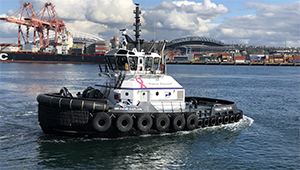Dozens of RAmparts-series tugboats designed by Robert Allan Ltd. work in North American ports, but none quite are like Harley Marine Services’ Dr. Hank Kaplan and Rich Padden.
These 5,350-hp RAmparts 2400 harbor tugs are the first with Caterpillar integrated propulsion systems featuring Cat engines and z-drives. Cat also supplied electrical generators powering the 80-by-36-foot vessels.
Diversified Marine of Portland, Ore., delivered Dr. Hank Kaplan in mid-2017, and Rich Padden followed about five months later. Seattle-based Harley Marine assigned both to Starlight PNW, a newly formed unit providing ship-assist and barge-handling services in Puget Sound. Diversified is building a third tug in the series, Vern Patterson.
Capt. Mitchell Hetterle described the tugs as nimble, stable and powerful. He said they’re responsive and forgiving, particularly when handling barges, which account for a good chunk of Harley’s Seattle-area business.
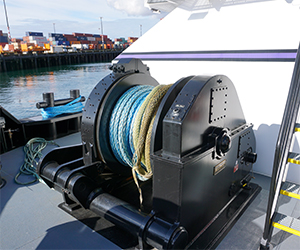 |
|
The Markey bow winch aboard Rich Padden. |
“It’s a pretty effortless boat in any situation you put it in because it handles so good,” he said during a March ride aboard Rich Padden in Seattle. “It opens up a lot of doors.”
“It’s my favorite boat to run,” he added. “This boat is the sportiest of all of them.”
Robert Allan’s RAmparts series is one of the most widely adopted designs anywhere in the world. More than 400 such tugs have been built over the years across 18 different platforms ranging from 22 to 36 meters. The length denotes the platform; RAmparts 2400-series tugs are 24 meters long and so on.
The design itself is optimized for ship handling. It features a modified skeg and rounded bow, as well as an elevated wheelhouse for all-around visibility. The raised forecastle offers additional freeboard but not enough to prevent close-quarters work in a ship’s flare.
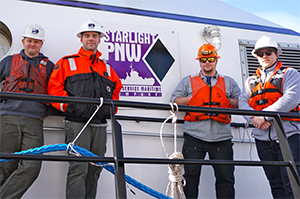 |
|
Rich Padden crew, from left: engineer Joseph Corey, Capt. Mitchell Hetterle, junior captain Tanner Lippincott and AB/deck hand Wes Shoemaker. |
“It’s just got a good hull form,” said Jim Hyslop, a Robert Allan Ltd. naval architect who worked on the updated design. “It’s very maneuverable, it goes sideways very well and it goes astern very well. Those are the main characteristics — good omnidirectional performance.”
“It’s a compact and efficient harbor tug for ship docking,” he added.
Dr. Hank Kaplan and Rich Padden represent the latest RAmparts design for Harley Marine. The 3,800-hp tugs Tim Quigg and John Quigg (since repowered to 4,500 and 4,800 hp, respectively) launched the series in 2004. They were followed 11 years later by Michelle Sloan and Lela Franco. These so-called “enhanced” Quigg-design tugs are more powerful with 5,350 hp, and their beams are four feet wider at 36 feet.
“These two with the new engines and drive units and the … enhancements we’ve built over the years are really the third generation,” Matt Godden, Harley Marine’s senior vice president and chief operating officer, said of Dr. Hank Kaplan and Rich Padden.
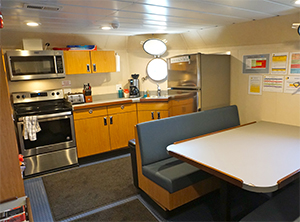 |
|
The galley and mess aboard Rich Padden is comfortably equipped for its four-person crew. |
Harley Marine and its chief executive, Harley Franco, have long favored Caterpillar engines. And over the last six or seven years, its tugs have been early adopters for new Cat technology. Prior examples of this partnership include Ahbra Franco, built in 2013 with Cat’s continuous pull engines, and Earl W. Redd, the first EPA Tier 4 boat, which entered service early last year.
“We’re the ‘beta test site’ sometimes is one way to explain it,” Franco said in an interview. “They know the product, and we are putting it in our vessels and we are giving them daily input — the good, the bad and the ugly.
“It’s like a cohesive mission between our company and theirs to develop a better product,” he continued.
Caterpillar’s foray into z-drive units stems from its 2013 acquisition of Berg Propulsion, a Swedish company with a proven line of azimuthing thrusters. These units have been in use on workboats around the world but, until now, not in the U.S. Cat has rebranded Berg’s products under the trade name Cat Propulsion.
“We took the legacy design we had from Berg Propulsion products and changed them to match our 3500-series engines, so it really optimized the performance of the units with these engines,” said Emil Cerdier, Cat Propulsion Americas sales manager.
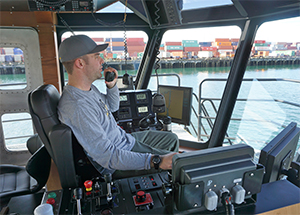 |
|
Capt. Mitchell Hetterle steers Rich Padden along the Seattle waterfront. |
One big selling point, he said, is the integration between the engines and the drives. Another is the ability to monitor the entire propulsion system from a dedicated wheelhouse display.
Cat’s drives have a slip clutch function that lets the operator reduce propeller rpm to as low as 35 rpm. Operators can “clutch in” during normal working operations when additional power is needed. The system is operated from an integrated bridge control unit, and has proven popular with Harley’s captains.
“That has been extremely useful for us, not necessarily in regards to ship assist, but for maneuvering and assisting with barge handling,” said Capt. Jonah Petrick, who runs Dr. Hank Kaplan. “It’s also good for maneuvering and docking in sensitive areas where prop wash is a concern.”
Propulsion comes from twin Caterpillar 3516C Tier 3 engines driving Cat MTA 524 z-drives through Centa shafts. The Cat C7.1 129-kW gensets provide ship service power represent an upgrade over recent predecessors in the series. Bollard pull is rated for 68 short tons ahead.
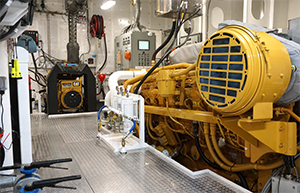 |
|
Dr. Hank Kaplan and Rich Padden have all-Caterpillar engine rooms. |
Deck gear consists of a Markey DEPC-32A winch on the stern and a Markey DEPC-48 on the bow, both spooled with Samson AmSteel-Blue line. A Burrard Iron Works capstan is installed on the foredeck to help with line handling.
The interior on Harley’s latest RAmparts 2400 tugs hasn’t changed a great deal from the second-gen models. The main deck features a mess and galley plenty suitable for four people and the captain’s cabin. Down one level, there are two more shared rooms. Vibration and sound-deadening material was used throughout the accommodations spaces.
The wheelhouse is spacious and bright, with an array of Furuno navigation electronics and Nauticomp displays. The helm station is further forward than in the second-gen vessels, offering a better view over the front of the tug, Hetterle said. Large windows provide 360-degree views, while CCTV cameras let the operator see what’s happening elsewhere on the vessel. The height of eye is 29 feet.
Both tugs have a custom fendering package that includes a 36-by-18-inch Shibata cylindrical fender at the main deck level above 12-inch, loop-type Schuyler fenders. Laminated bow fenders are located below the main deck and knuckle.
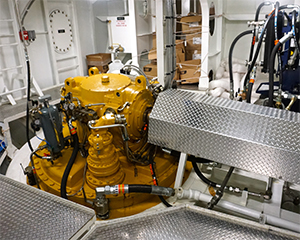 |
|
The two tugs also are the first in the U.S. with Cat-branded z-drives. |
“Cylindrical fender is a soft contact when you initially make contact with the ship, and as you increase your push, what happens is you increase the contact area and therefore get lower pressures,” explained Hyslop, the naval architect.
The two new tugs, as well as the third one under construction at Diversified, are named for people with close ties to Harley Marine. Dr. Hank Kaplan is a cancer researcher at a prominent Seattle hospital, and Harley has long donated proceeds from an annual golf event to Kaplan’s cancer research fund.
Rich Padden is a Harley Marine board member and education advocate for students of diverse backgrounds. He and his wife, Laurie, also launched the Cystic Fibrosis Seattle Guild that has raised more than $100 million for research. Vern Patterson, who passed away in 2015, was a longtime Caterpillar employee who had close ties with Harley Marine.
Since entering service, the new tugs’ performance has matched their pedigree. They’re earning strong reviews from captains, crews and local pilots, and they’ve proven effective and efficient at docking ships and handling barges.
In short, Godden said, they’ve been exceptional all around.

